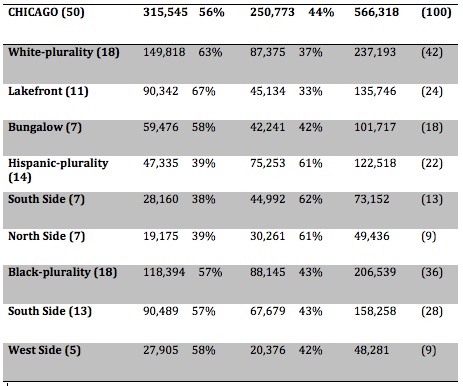Rahm Emanuel has been re-elected mayor of Chicago by a 56 to 44 percent margin . That’s about what I expected when I wrote my Washington Examiner column last month of the mayoral race there. I wrote that Emanuel was amassing an alliance of gentry liberals and blacks. That’s exactly what happened, as the data compiled by Chicago magazine shows.
I have added the results from each of the 50 wards, characterizing them as white-, Hispanic- or black-plurality as Chicago does. I note that two wards which according to census data were white-plurality in 2010 are listed as Hispanic-plurality now; I presume that is the result of significant population shifts. I have further divided these three groups of wards into two each: Lakefront (wards 2, 32, 40, 42-44, 46-50) and Bungalow (1, 11, 19, 38-39, 41, 45) for white-plurality; South Side (10, 12-15, 22-23, 25) and North Side (26, 30-31, 33, 35-36) for Hispanic-plurality; and South Side (3-9, 16-18, 20-21, 34) and West Side (24, 27-29,37) for black-plurality). My numbers will be a little off from the official totals because they are based on 99 percent of precincts reporting and also because of possible arithmetic errors; but the discrepancies seem sure to be insignificant.
The following table shows the number of votes and percentages for Emanuel and for his runoff opponent Chuy Garcia, and the total number of votes cast. The numbers in parentheses after each category represent the number of wards, which were designed to be of equal population in the 2010 Census. The numbers in parentheses after the totals represent those votes as a percentage of the entire city.

These numbers show ethnic voting patterns that are clear, but far from unanimous. White wards voted heavily for Emanuel, more on the Lakefront than in the few remaining Bungalow wards; Hispanic wards voted almost as heavily for Garcia; and black wards voted by a pronounced but not overwhelming margin for Emanuel. It should be noted that most ward populations are not ethnic homogeneous, though a few are: Wards 6, 8, 17, 21 and 34 on the South Side are 97 or 98 percent black (2010 Census); ward 22 next door to Cicero is 93 percent Hispanic and Lakefront wards 43 and 44 are 83 percent white (with 8 percent, presumably mostly Asian, not in any of the three groups). You can get a more granular picture of the results from Chicago’s precinct map (scroll down for map).
Observations:
1. Emanuel’s base is the Lakefront wards, where he got 70 percent of his citywide popular vote margin. Another 27 percent came from the Bungalow wards. Chicago no longer has a white majority. But the 18 white-plurality wards cast 42 percent of the city’s votes. This is a different coalition from the one which first elected Richard M. Daley in 1989. His base was the then larger number of Bungalow wards and he added to them Lakefront and Hispanic wards.
2. “People of color” don’t all vote the same. Hispanic-plurality wards went 61 percent for Garcia, black-plurality wards 57 percent for Emanuel. President Obama’s endorsement surely helped his former White House chief of staff; Jesse Jackson’s endorsement of Garcia did not produce among blacks a majority for his candidate, much less than near-unanimous support that Harold Washington received from his fellow blacks in the 1983 and 1987 elections.
3. Back in the 1980s it seemed that Chicago was on its way to a black majority. That hasn’t happened, in part because blacks have been moving to southern suburbs and in part because of the large increase of Hispanic population. Nevertheless, turnout in the 18 black-plurality wards was nearly double (69 percent higher) than in the 14 Hispanic-plurality wards. One easy explanation is that many Hispanic residents aren’t U.S. citizens; another, more tentatively advanced, is that the degree of political organization in black-plurality wards is much higher than in Hispanic-plurality wards.
4. Turnout is a measure of civic involvedness and in concern about the election. It was highest in two Bungalow wards at the edge of the city, ward 19 in the far southwest (19,828) and ward 41 in the far northwest (18,373). The highest turnout (13,603) in a Hispanic-plurality ward was in ward 13, in the southwest part of the city; this probably represents a high white turnout pushed by Michael Madigan, who has been Democratic ward committeeman there since 1969 and Speaker of the Illinois House of Representatives (except during two years of Republican control) since 1983. The highest turnout in a black-plurality ward was in ward 8 on the South Side (15,345).
5. Aficionados of election returns are used to seeing the highest percentages cast for candidates in heavily black constituencies. But in Chicago the highest percentages in wards were cast in the most affluent Lakefront wards, 85 percent for Rahm Emanuel in the 42nd ward just north of the Loop and 83 percent in the 43rd ward just to the north. Chuy Garcia approached that percentage only in ward 22, where he won 80 percent, but the turnout there (6,900) was the third lowest of the 50 wards. Black-plurality wards all went for Emanuel, by percentages ranging from 51 percent to 66 percent.
6. Is Rahm Emanuel mayor for life, as Richard J. Daley was and, for a while, Richard M. Daley seemed likely to be? Not necessarily. A candidate who could build a coalition of any two or the three major groups (gentry liberals, blacks, Hispanics) could probably beat him. Chicago does have one major political figure who demonstrated in his state legislative career the ability to form a coalition of blacks and gentry liberals. He, however, has another job these days which keeps him (as they say in Chicago) out of town.

